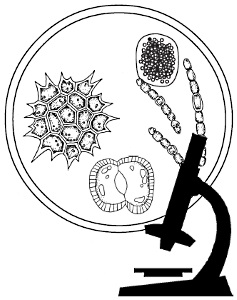Common Aquatic Plant Management Problems
Please note:
This information is intended for educational purposes only. References to commercial
products or trade names are made with the understanding that no discrimination is intended of
other products which may be available. Any herbicides recommended herein for the treatment
of aquatic vegetation have been registered by the Environmental Protection Agency for use
in the manner described. The registration and use of a particular product may change
therefore the information provided here may not remain current indefinitely. It is the
responsibility of the user to read and follow the manufacturer's label to prevent misuse
of the product.
Planktonic Algae

Common Name: Blue-green algae/micro-algae
Distribution and Habitat
Numerous species of microscopic, single-celled algae may be found in ponds throughout the state. Most of these alga make up the phytoplankton or periphyton and are considered a beneficial component of the food chain. One of the most common nuisance algae belongs to a group known as the blue-green algae. Species of this group will tolerate a wide range of habitats but thrive during warmer months in nutrient rich waters. These microscopic algae are suspended in the upper reaches of the water column and under favorable conditions produce dense blooms. Such situations may produce an unsightly surface scum, foul odors in the water and sometimes off flavor in fish flesh. Toxic substances produced by some blue-green algae have been attributed to sickness in livestock, wildlife and even humans. Oxygen depletions due to die-offs of blue-green algae may cause fish kills.
Description
Microscopic examination of individual cells of blue-green algae is usually required to identify the species. These cells may be spherical or elongate and may occur singularly but more often form aggregate clumps or flakes suspended within the water column. At this stage the bloom becomes easily visible to the eye and may give the water an overall pea soup green or brownish appearance. Thick surface accumulations have been be described as resembling green or blue- green paint on the water. Temporary dispersal of the algal blooms is often triggered by cooling of surface water temperatures due to rain events or frontal passages.
Recommended Control Methods
1. Chelated Copper
Active Ingredients: Elemental copper from copper triethanolamine
Product Names: K-Tea; Cutrine; Cutrine Plus
Approximate Cost: $18.00-$30.00/gallon
Application Rates: Dependent upon acreage to be treated and desired
concentration (See Below). Most planktonic algae can be controlled by chelated copper
concentrations between 0.2 ppm-1.0 ppm (parts per million)
| Depth of Water (feet) | Gallons of Chelated Copper per surface acre to achieve desired concentration in parts per million (ppm) | |
|---|---|---|
| 0.20 ppm | 0.50 ppm | |
| 1 | 0.7 | 1.7 |
| 2 | 1.4 | 3.4 |
| 3 | 2.0 | 5.1 |
Application Methods and Tips:
Control of blue-green algae is best achieved when the algaecide is applied at the first signs of algal bloom. Water temperatures should be a least 65. Even distribution of the algaecide over the pond is desired. This may be accomplished by mixing the material with water and applying over the pond as a spray solution or simply pouring the mixture throughout the pond using a boat. Care should be exercised when treating ponds with dense growths of algae to prevent oxygen depletions due to the decomposing plants. No more than one-third of the pond should be treated at any one time, allowing a 7 day interval between applications. Additional product directions and precautionary statements are listed on the herbicide container. READ AND FOLLOW THE HERBICIDE LABEL
2. Copper Sulfate-Bluestone
Active Ingredients: Copper Sulfate (Pentahydrate)
Product Name: Copper Sulfate
Approximate Cost: $10.00-$15.00/5lbs.
Application Rates: 0.8 lbs-1.75lbs /acre foot* Exact dosage rates are dependent upon acreage
to be treated and desired concentration of the product. This should be carefully
calculated at the time of treatment as directed on the product label.
* One acre foot=one surface acre x one foot of depth
Application Methods and Tips:
Control of blue-green algae is best achieved when the algaecide is applied at the first signs of algal bloom. Water temperatures should be a least 65. Even distribution of the algaecide over the pond is desired. This may be accomplished by mixing the material with water and applying over the pond as a spray solution or simply pouring the mixture throughout the pond using a boat. Care should be exercised when treating ponds with dense growths of algae to prevent oxygen depletions due to the decomposing plants. No more than one-third of the pond should be treated at any one time, allowing a 7 day interval between applications. Additional product directions and precautionary statements are listed on the herbicide container. READ AND FOLLOW THE HERBICIDE LABEL
Note:
Extreme care should be exercised when using these products in acid or soft waters (water
hardness less than 50 ppm) due to increased toxicity to fish under these conditions.
Do not exceed recommended rates.
Consult the fisheries biologist serving your county or more details concerning use of these products.
3. Sterile Grass Carp (White Amur)
Grass carp are not considered an effective alternative for the control of planktonic algaeweed.The above information is available as a downloadable PDF - Planktonic algae
